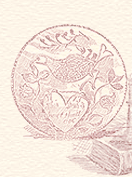Feature Article
2001: A BOUNTIFUL YEAR FOR FRAKTUR
by Russell and Corinne Earnest
The year 2001 is special. It ushered in three fraktur exhibits making it
possible for fraktur lovers and scholars to wallow in the largest number of
freehand and printed fraktur ever on display at one time. A rainbow of tulips,
hearts, parrots, peacocks, and angels of every size, shape, and color imaginable
greets those attending the three exhibits in Reading, York, and Pennsburg,
Pennsylvania. But just as important as the number of fraktur available for this
public feast is the perspective on American fraktur that each exhibit offers.
Since the Pennsylvania German Folklore Society published Dr. Donald A. Shelley's
The Fraktur-Writings or Illuminated Manuscripts of the Pennsylvania Germans
forty years ago, a small army of scholars has intensely examined the complex
field of fraktur. Shelley's book inspired not just a handful of students of
fraktur, but many students, and the number is growing. Shelley has often
remarked, he knows of few disciplines that have been researched and written
about more than fraktur. Yet despite the work of this determined band of
researchers, the study of fraktur remains complex - and by many accounts
understudied, for there continue to be significant voids in fraktur research.
The number of articles and books published on fraktur has accelerated,
especially in the last two decades, and exhibit curators have capitalized on
what appears to be an insatiable appetite on the part of the public to learn
more about these gems of eighteenth and nineteenth century manuscript art
produced by and for Pennsylvania Germans. In fact, the very reason curators can
create meaningful exhibits is because the past forty years of research, which
Shelley's book prompted, have become building blocks for such exhibits.
The Berks County Exhibit in Reading
Richard and Rosemarie Machmer of Hamburg, Pennsylvania, guest curated the
exhibit in Reading at The Historical Society of Berks County. The Machmers
recognized the pivotal role Berks County artists and printers played in the
development and distribution of the birth and baptism certificate, or Geburts
und Taufschein (plural, Geburts und Taufscheine). The Machmers emphasized the
Berks County contribution to fraktur by focusing on the development of the
Taufschein over a span of more than a century.
Taufscheine are the most numerous type of fraktur. They were immensely popular
among Lutheran and Reformed families, and Lutheran and Reformed families
represent the highest percentage of families of German heritage in Berks County.
Thus, in the closing decades of the eighteenth century and throughout the
nineteenth century, major fraktur artists, scriveners, and printers of
Taufscheine lived in or crisscrossed Berks County creating Taufscheine for an
eager market. Reading, the largest city in Berks County, was important for its
German printers and was the birthplace of the printed three-heart certificate
(c. 1790-1810), followed by the angel-type. The immensely popular angel-type
forms dominated printed Taufscheine for over a hundred years (c. 1805-1920).
These certificates were hand-decorated and widely distributed by fraktur artists
and scriveners.
The Berks County exhibit offers more than one hundred examples of fraktur, both
printed and freehand. Major fraktur artists worked in Berks County including
Friederich Krebs (1749-1815), Daniel Schumacher (c. 1729-87), Martin Brechall
(c. 1757-1831), Henrich Weiss (active c. 1776-1808), Friederich Speyer (active
c. 1774-1802), the I.T.W. Artist (active c. 1805-11), Conrad Gilbert
(1734-1812), and Conrad Trevits (1751-1830), all of whom have works exhibited.
For purposes of the exhibit, the Society collection is supplemented by additions
from two private collections, the first time examples by some major artists have
been on display.
In addition to fraktur, objects showing fraktur motifs are on exhibit. These
include textiles, cookie cutters, redware, and more. Importantly, the exhibit
includes printing blocks engraved by Carl Friedrich Egelmann (1782-1860) of
Reading, who printed Taufscheine, and an array of notes made by Berks County
scrivener Georg August S. Hainbach (active c. 1876-1919). These notes, made on
an assortment of papers ranging from tobacco advertisements to ruled note paper,
show how Hainbach kept records about fraktur he owed to clients.
|
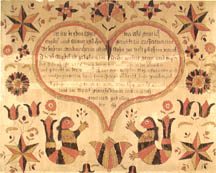
|
Figure 1. Birth and baptism certificate drawn by the anonymous I.T.W. Artist. He
recorded that Jacob Seydel was born December 1, 1776 in Bern Township, Berks
County. In all likelihood, this Taufschein was actually drawn about 1810 by this
Berks County artist best known for his folky mermaids and strong, contrasting
colors. (Photo courtesy of Richard and Rosemarie Machmer)
|
|
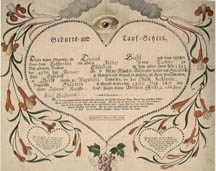
|
Figure 2. Birth and baptism certificate printed by Hütter and Son in Easton,
Pennsylvania, and decorated by an anonymous artist. Christian Hütter in
partnership with his son, Georg, printed the certificate between 1816 and 1820.
The decorator possessed an extremely fine hand. He decorated Elisabeth Biehl's
Taufschein with grapes and vining flowers but most noticeably, the "right" eye
of God - a most life-like motif. The "Eye of God" is often printed on
certificates dating after 1875. (Photo courtesy of The Historical Society of
Berks County) |
The York County Exhibit in York
If Berks County became the "heart" of Taufschein production east of the
Susquehanna River, York County could claim the same west of the Susquehanna.
Both counties boast major fraktur artists, and both boast major Taufschein
printers. June Lloyd, Librarian at the York County Heritage Trust, launched a
fraktur exhibit that includes works from York and Adams County. Like Berks
County, York and Adams Counties had mostly Lutheran and Reformed families among
their German populations. Thus, Taufscheine dominated the fraktur market in this
region just as this type of fraktur numerically dominated Berks County examples.
The York County exhibit has more than seventy fraktur on display including works
by major artists such as Adam Wuertz (active c. 1813-36), Johann Zug (active c.
1775-1801), Daniel Peterman (1797-1871), Francis Portzline (1771-1857), Johannes
Bard (1797-1861), the Sussel-Washington Artist (active c. 1760-84), and more.
The York County exhibit introduces little known artists such as Peter Marcle and
George K. Gantz, who made freehand fraktur in York County in the mid-1800s. More
examples by these artists will likely become known now that Lloyd has identified
their works.
Importantly, like the Berks County exhibit, the exhibit in York shows a variety
of printed Taufscheine. Printed forms from York and Hanover in York County rate
among the most varied and interesting prints from any region of southeast
Pennsylvania. Printers such as Salomon Mayer (died 1811), Johan Philip Starck
(active c. 1805-16), Daniel Philip Lange (1783-1856), Daniel Wilhelm Lepper
(died 1842), Samuel Endredy Stettinius (active c. 1797-98), and others
introduced an amazing variety of editions, many of which were successfully
marketed throughout Pennsylvania, Maryland, Ohio, and the Shenandoah Valley in
Virginia.
The great surprise regarding the exhibit of York and Adams County fraktur is
that this is fraktur from west of the Susquehanna - an area thought by some to
have limited Pennsylvania German decorative arts. As the exhibit demonstrates,
there was a rich fraktur heritage in York and Adams Counties. In a short five
years, Lloyd inventoried more than 1,200 fraktur from the area. At the beginning
of her project, no one imagined she would have this kind of success.
|
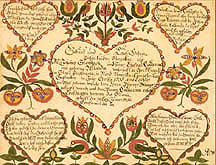
|
Figure 3. Birth and baptism certificate drawn by Adam Wuertz (active c. 1813-36) recording the September 10,
1835 birth of Catharina Stambach in York County. Little is known regarding
Wuertz except he was a schoolmaster and York County's second most prolific
frakturist. He also infilled printed Taufscheine and apparently knew only
German. (Photo courtesy of the York County Heritage Trust)
|
|
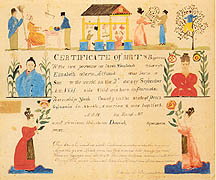
|
Figure 4. Birth and baptism certificate drawn by York County's most prolific frakturist, Daniel Peterman (1797-1871). This example records the birth of
Daniel Stombach on September 2, 1841 in Paradise Township, York County. This
example is particularly interesting because it includes scenes from everyday
life, much in the style of York's most famous artist, Lewis Miller (1796-1882).
Peterman, a schoolmaster and stone cutter, infilled printed Taufscheine and
family registers and drew freehand fraktur until 1864. (Private Collection)
|
The Schwenkfelder Exhibit in Pennsburg
In regions of southeast Pennsylvania where German-speaking populations had
greater numbers of families belonging to smaller religious denominations, such
as Mennonites, Amish, Moravians, and Schwenkfelders, we find a higher ratio of
fraktur types other than the Taufschein. For example, Bucks and Montgomery
Counties have many Mennonite and Schwenkfelder families. Mennonites and
Schwenkfelders do not practice infant baptism so there was no demand for
Taufscheine. Although these religious sects do not have Taufscheine among their
fraktur, they do have significant fraktur traditions. Consequently, the exhibit
at the Schwenkfelder Library & Heritage Center at Pennsburg, Pennsylvania, shows
more variety in terms of types of fraktur than the other two exhibits.
Every example displayed at Pennsburg is freehand rather than printed. But just
because the Schwenkfelder examples are freehand does not mean they are
necessarily earlier than examples seen in the Berks and York County exhibits.
For example, it may surprise some that Berks County displays printed forms that
date earlier than much Schwenkfelder freehand fraktur. And while many thought
most York County fraktur is later than fraktur east of the Susquehanna River,
the York County exhibit includes early examples, such as two Vorschriften
(writing examples) made in Manchester Township that date 1758 and 1765.
The Schwenkfelder exhibit, curated by Deborah Rebuck, features fraktur made by
David Kriebel (1787-1848), who is credited with bringing classic Schwenkfelder
motifs to their zenith. Schwenkfelder fraktur was produced by a sect residing
primarily in Montgomery County, Pennsylvania. Design elements reminiscent of
eastern Europe are more apparent in Schwenkfelder fraktur than in examples from
other regions of southeastern Pennsylvania. Colors used on Schwenkfelder
manuscript art are rich and strong. And the fullness of design mixed with
complex strapworking within fraktur lettering creates a texture that can be
described as sensational. The Schwenkfelder exhibit consists of almost one
hundred examples, many of which represent the best of Schwenkfelder art.
Every geographic location leaves its individual mark on fraktur. The artists and
scriveners that worked in a specific location, the prevailing religious
denomination, the availability of printers, the time period and the taste of the
consumer - all had bearing on the fraktur culture of a particular area. Thus,
fraktur from a specific location takes on an identity, and this identity is
reflected in each of the current exhibits. The problem for curators of the three
exhibits was to convey this identity to the public. Is was a tough job,
considering much of the public knows little about fraktur let alone
understanding regional similarities and differences.
|
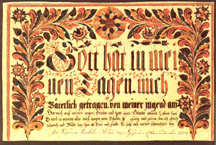
|
Figure 5. Religious text attributed to David Kriebel (1787-1848) drawn for the
widow, Susanna Kriebel, on December 16, 1804. David Kriebel, a Schwenkfelder
farmer and minister, lived in Worcester Township, Montgomery County. Kriebel
made fraktur beginning in his teenage years, yet his works show amazing
development and maturity. He is credited with bringing to its zenith the classic
Schwenkfelder motifs of broad, rich borders colored in thick gum Arabic. An
interesting study would be to find his mentor and source of motifs and
technique. (Photo courtesy of the Schwenkfelder Library & Heritage Center)
|
|
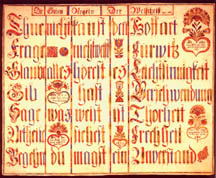
|
Figure 6. Seven Rules of Wisdom attributed to Susanna Heebner (1750-1818), a
Schwenkfelder woman who never married and probably lived on the family farm in
Worcester Township, Montgomery County. Heebner dated this "puzzle fraktur" July
2, 1809. The student of fraktur would recognize the piece as Schwenkfelder by
the "fan flower" above the hearts, and the subject matter. The Seven Rules of
Wisdom, and for that matter puzzle fraktur, are far more rare than the
Taufscheine. A significantly higher percentage of ministers and women artists
were found among Schwenkfelders than the much more numerous Reformed and
Lutheran frakturists. (Photo courtesy of the Schwenkfelder Library & Heritage
Center) |
Quilts, Guns, Cookie Cutters - and Fraktur
We speak from experience when we say that those who author books and lecture on
the subject of fraktur, and those who curate exhibits on the subject encounter
tremendous difficulties. The single greatest obstacle when introducing fraktur
to the public is the language barrier. More than eighty percent of American
fraktur was written in German. Thus, the exhibit curator must interpret the
meaning, use, and importance of an illuminated document the visitor cannot read.
Moreover, many people still have misconceptions about fraktur - assuming they
are familiar with the subject at all. Some believe that fraktur were marriage
records made by preachers. Because of the naive art on fraktur, many believe
most fraktur were made by children. And many believe the same types of decorated
manuscripts can be found in Europe.
In truth, schoolmasters and later, professional scriveners made most fraktur.
Only a small percentage of fraktur was marriage records. And by far, most
freehand and printed fraktur were Taufscheine, recording dates of birth and
baptism for a child while providing the parents' names, location, and names of
sponsors. As important as these documents were among American Lutheran and
Reformed families, Taufscheine were rarely made in Europe.
Like others dealing with the complex study of fraktur, the curators of the three
current exhibits faced the all too familiar and daunting task of getting across
these concepts to visitors ranging from those who have never heard of fraktur to
fraktur aficionados who are sure to visit every fraktur exhibit possible. The
task of each curator would have been easier if they were exhibiting quilts or
long rifles or cookie cutters. The public immediately recognizes and understands
these objects. But relatively few museum goers from outside southeast
Pennsylvania know what a fraktur is.
It is no small task to introduce fraktur to the general public. That public
ranges from the woman from Boise, Idaho, who wants to learn more about her
ancestor's baptism certificate, to a Japanese businessman visiting the United
States, to groups of ethnically mixed grade-school children, to a family whose
vacation in the "Pennsylvania Dutch" country is limited and whose children want
to hurry on to an amusement park in Hershey. Moreover, the public also includes
beginning to advanced - and knowledgeable - scholars and collectors. Reaching
out to all these people requires a great deal of explanation. The curator must
explain who the Pennsylvania Germans are and their love of decoration. They must
explain fraktur lettering. They must explain why fraktur are written in German
and what they say. They must explain when these manuscripts were made, why they
were made, and who made them. They must touch on various faiths among the
Pennsylvania Germans. In short, they must deal with many disciplines all at
once. And they must get their message to the public quickly and succinctly -
boiling each idea down to no more than a few lines on a label the size of a
three-by-five note card.
Fortunately, today's curator has an intense forty years of research at his or
her disposal. Prior to Shelley's work, there existed publications on fraktur,
but these publications were few and, of necessity, they covered broad concepts.
Since Shelley, major studies have been published. Most notable is Prof. Dr.
Klaus Stopp's six-volume study of printed birth and baptism certificates. The
Printed Birth and Baptismal Certificates of the Pennsylvania Germans was a key
resource for the Machmers and for Lloyd. Had it not been for Stopp's
publication, it would have been difficult, if not impossible, to determine that
Reading printers enjoyed the longest history in America of printing the
Taufschein. Stopp's study also made it clear that although Reading printers were
not the first to print Taufscheine, they introduced to the market the
three-heart certificate and the angel-type certificate. This publication was
also important in the study of hand-decoration used on Taufscheine, for it
points out that Reading printers, unlike printers in Allentown, Harrisburg,
Philadelphia, and beyond, resisted the use of technology that allowed the
printer to print color. Instead, the Berks County market continued to enjoy
hand-color decoration on their angel-type prints even into the opening decades
of the twentieth century. It was as if this segment of the Pennsylvania German
culture determinedly stuck to their love of folk decoration.
In all, the past forty years of research have provided scholars, exhibit
curators, historians, writers, and even genealogists looking for family names on
fraktur the tools they need not only to understand these documents, but to
interpret them and put them in perspective. Emphasis on perspective is needed.
If the uninitiated were to read about Schwenkfelder fraktur or attend the
Schwenkfelder exhibit, in isolation and without the benefit of other resources,
he or she would think Schwenkfelder fraktur represents all American fraktur.
Yet, as important as Schwenkfelder fraktur is, it is actually atypical of most
American fraktur, for the Taufschein would not be represented.
One of the most exciting developments concerning recent research is that
regional comparisons of fraktur bring greater understanding of these documents.
We now understand why one printed form is more rare than another. We understand
what is unique about each fraktur and why it is unique. We understand how each
example fits into the greater scheme of fraktur production. We recognize
"firsts" and "lasts" in fraktur. The three exhibits give insights that make
regional identity more clear. Consequently, there is no way to compare the
exhibits. In fact, if a visitor from California were to ask you which to see,
your answer should be, "See them all!"
And you might add they should waste no time, for these exhibits end soon. The
exhibit at the Schwenkfelder Library & Heritage Center in Pennsburg ends
September 30, 2001. Following closing, there are plans to take the exhibit on
tour. Moreover, beginning December 1, 2001 through March 31, 2002, the
Schwenkfelder Library & Heritage Center will feature a fraktur exhibit entitled
"A Celebration of Pennsylvania Fraktur" examining regional differences including
Schwenkfelder fraktur not exhibited before. The Historical Society of Berks
County exhibit ends September 22, 2001. However, the Society rotates displays of
many of their fraktur, so that some examples can be seen throughout the year.
And the York County Heritage Trust exhibit ends October 31, 2001.
And for Those Who Missed the Exhibits . . .
Not all is lost if your California friend made plans too late to see all three
exhibits. As important in their own right are the publications associated with
the exhibits. Dennis Moyer's 301-page Fraktur Writings and Folk Art Drawings of
the Schwenkfelder Library Collection is the standard reference regarding Schwenkfelder fraktur. Along with dazzling illustrations, Moyer presented
biographical data on many of the Schwenkfelder artists. Published in 1997/98 by
the Pennsylvania German Society, the book has over 250 color photographs.
Richard Machmer's 22-page catalog titled Berks County Pennsylvania Fraktur: Gerburts [Geburts]
Und Taufscheine presents an overview of Berks County fraktur,
a county where freehand Taufscheine blossomed and printed Taufscheine matured -
without surrendering its folk-art quality. Included in the catalog are over
thirty color photographs and a look at some of the more important artists,
scriveners, and printers. And June Lloyd's 132-page book, Faith and Family:
Pennsylvania German Heritage in York County Area Fraktur addresses regional
fraktur from an historical and cultural context as well as presenting checklists
of York County area artists and printers. This book contains over fifty
beautiful color illustrations. It is a surprise to the most seasoned student of
fraktur because of the variety and quality of fraktur produced in an area west
of the Susquehanna River.
Not associated with a current exhibit is the Pennsylvania German Society
publication, Bucks County Fraktur, which will be available in September 2001.
The unprecedented level of exhibit space and publications dedicated to fraktur
in 2001 demonstrates the continued interest among collectors, museum goers, and
scholars in enjoying this special aspect of Pennsylvania German folk art.
Donald A. Shelley - An Ever-Present Influence
We would be remiss if we did not close with a personal observation. Dr. Donald
A. Shelley, dean of fraktur scholars, was a force regarding all exhibits and
resultant publications. Shelley was instrumental in getting Fraktur Writings and
Folk Art Drawings of the Schwenkfelder Library Collection published and he wrote
the foreword. As a long time resident of Berks County, he is eminently familiar
with Berks County frakturists - in fact, being the first to identify many Berks
County artists and scriveners. As such, he played a key role in the Berks County
exhibit and co-wrote the introduction to Berks County Pennsylvania Fraktur. But
interestingly, Shelley is a native of York County, Pennsylvania. Like the
authors of this essay, June Lloyd is a life-long admirer of the man who made
fraktur a mainstay of American decorative arts. Thus Lloyd, and the York County
Heritage Trust, were honored that Shelley wrote the foreword to Faith and
Family. Seldom has a field of study been so positively affected by the work of
one man.
For More Information:
York County Heritage Trust
250 East Market Street
York, PA 17403
717- 848-1587
www.yorkheritage.org
Schwenkfelder Library & Heritage Center
105 Seminary Street
Pennsburg, PA 18073
215-679-3103
www.schwenkfelder.com
The Historical Society of Berks County
940 Centre Avenue
Reading, PA 19601
610-375-4375
www.berksweb.com/histsoc
ABOUT THE AUTHORS
Russell and Corinne Earnest have written numerous books and articles on fraktur
including Papers for Birth Dayes: Guide to the Fraktur Artists and Scriveners
(1997) and Fraktur: Folk Art & Family (1999). In 1997, the Earnests guest curated a fraktur exhibit for the Heritage Center Museum of Lancaster County in
Lancaster, Pennsylvania.
Home
| PA German Culture | Current News |
PA
German Dialect
Links of Interest | Membership |
Publications | Order Form
Our mailing address is: The
Pennsylvania German Society
P.O. Box 118
Ephrata, PA 17522
(717) 597-7940
E-mail:
pgs@innernet.net ©
Copyright 2005.
The Pennsylvania German Society
updated 4/1/2020 TJG
|
